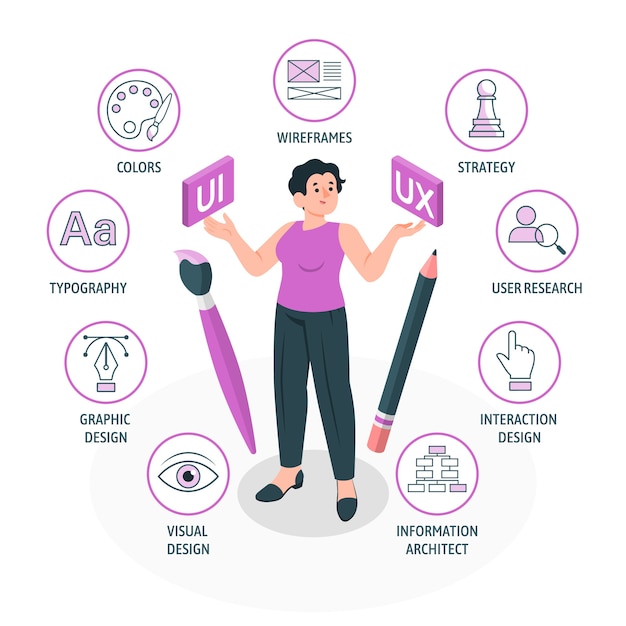UX UI Design Services: Crafting Seamless Digital Experiences
In today’s fast-paced digital ecosystem, delivering exceptional user experiences is more important than ever. UX UI design services stand at the core of creating intuitive, visually appealing, and user-centric digital products. Whether it’s a mobile application, a responsive website, or a software interface, the combination of UX (User Experience) and UI (User Interface) design is what transforms a good idea into a functional and engaging product.
Understanding UX and UI Design
UX design refers to the overall experience a user has while interacting with a product or service. It involves deep research, user behavior analysis, wireframing, prototyping, and testing to ensure that every element serves a purpose and contributes to a smooth user journey. UI design, on the other hand, focuses on the visual and interactive aspects. It deals with color schemes, typography, icons, button placement, responsiveness, and overall aesthetic appeal.
Why UX UI Design Services Matter
Businesses that invest in professional UX UI design services often witness significant improvements in user retention, conversion rates, and customer satisfaction. A well-designed interface reduces cognitive load, improves usability, and creates a lasting impression. With increasing competition in the digital space, standing out through superior design can be the difference between success and failure.
Key Elements of Effective UX UI Design
User Research: This is the foundation of any successful UX UI project. Understanding the target audience’s needs, goals, and pain points helps in crafting a design that resonates with users. Techniques include surveys, interviews, focus groups, and usability testing.
Information Architecture: Organizing content and functionality in a clear, logical structure ensures users can navigate seamlessly. Good information architecture reduces confusion and helps users find what they need quickly.
Wireframing and Prototyping: Wireframes are basic sketches or digital layouts that outline the structure of a page or interface. Prototypes are interactive simulations that showcase the flow and functionality. These tools are essential for testing and iterating on ideas before development.
Visual Design: Aesthetic elements such as colors, fonts, imagery, and iconography are crucial for creating an engaging interface. Consistency in design elements reinforces brand identity and improves recognition.
Interaction Design: This focuses on how users interact with the interface. Elements like buttons, transitions, animations, and feedback mechanisms are designed to make interactions intuitive and enjoyable.
Usability Testing: Iterative testing ensures that the design meets user expectations. Real user feedback is invaluable in identifying flaws and refining the experience.
Benefits of Hiring Professional UX UI Design Services
Enhanced User Satisfaction: A user-friendly interface leads to higher satisfaction rates. Users are more likely to return and recommend the product.
Increased Conversion Rates: Optimized user flows reduce friction, encouraging users to complete desired actions, such as signing up, making a purchase, or submitting a form.
Reduced Development Costs: Identifying and fixing usability issues during the design phase is significantly more cost-effective than post-launch changes.
Brand Loyalty: Consistent and delightful user experiences foster trust and loyalty, making users more likely to engage with the brand repeatedly.
Accessibility: Professional designers ensure that products are accessible to users of all abilities, complying with legal standards and expanding the user base.
Emerging Trends in UX UI Design
Voice User Interfaces (VUIs): With the rise of voice assistants, designing for voice interactions is becoming essential. UX designers are now exploring conversational design to enhance accessibility and user engagement.
Dark Mode Design: Offering a dark theme not only improves visual comfort in low-light environments but also extends battery life on OLED screens. It’s now a standard feature in many applications.
Microinteractions: These are subtle animations or design elements that provide feedback to user actions. They add delight and enhance the sense of responsiveness.
Personalization: Leveraging user data to deliver customized experiences improves relevance and satisfaction. Adaptive interfaces that respond to user behavior are becoming more prevalent.
Neumorphism and Glassmorphism: These visual styles use soft shadows and translucent effects to create depth and realism. They offer a fresh aesthetic while maintaining usability.
AI-Powered UX: Artificial intelligence is helping designers understand user behavior, predict preferences, and automate design processes, leading to more efficient and effective design iterations.
Industries That Benefit from UX UI Design Services
E-commerce: Smooth navigation, intuitive filters, secure checkout processes, and engaging product pages are critical for online stores.
Healthcare: Patient portals, health tracking apps, and telemedicine platforms must be easy to use, secure, and informative.
Finance: Mobile banking apps, investment platforms, and budgeting tools require trustworthy and straightforward interfaces.
Education: E-learning platforms, virtual classrooms, and LMSs (Learning Management Systems) benefit from user-centered design to facilitate learning.
SaaS: Subscription-based platforms must ensure their dashboards, onboarding flows, and data visualizations are intuitive and efficient.
Choosing the Right UX UI Design Service Provider
Portfolio Review: Examine previous work to assess design style, problem-solving ability, and industry relevance.
Client Testimonials: Feedback from past clients offers insights into reliability, communication, and project outcomes.
Design Process: A structured, user-centric design process with clear deliverables ensures transparency and accountability.
Team Expertise: Look for multidisciplinary teams with expertise in research, visual design, interaction design, and development collaboration.
Tool Proficiency: Familiarity with industry-standard tools like Figma, Adobe XD, Sketch, InVision, and usability testing platforms is a must.
Steps in the UX UI Design Process
Discovery Phase: Understanding business goals, user personas, market landscape, and project requirements.
Research Phase: Conducting competitive analysis, user interviews, and data analysis to inform design decisions.
Ideation Phase: Brainstorming ideas, creating user flows, and developing wireframes that map out the experience.
Design Phase: Creating high-fidelity mockups, interaction designs, and visual assets based on brand guidelines.
Testing Phase: Running usability tests to gather feedback and iterate on designs.
Handoff and Support: Delivering final assets to developers and offering design support during implementation.
Conclusion
UX UI design services are no longer optional in a digital-first world; they are fundamental to the success of any online product or platform. By prioritizing user needs and embracing innovative design practices, businesses can deliver experiences that not only meet expectations but exceed them. Partnering with the right design agency ensures that every pixel and interaction contributes to your brand’s story and user satisfaction. Investing in thoughtful, research-driven UX UI design is a strategic move toward digital excellence and long-term success.













